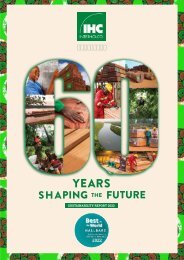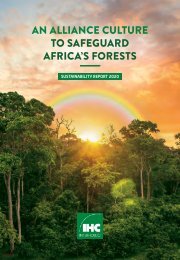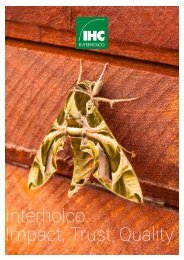Nomenclature Générale des Bois Tropicaux - 7ème édition
(english description below) Cette nomenclature est utilisée pour la mise à jour du 'Harmonized Code System' de l’Organisation Mondiale des Douanes. Dans la circulaire du 5 avril 2005, le Ministère de l’Economie, des Finances et de l’Industrie (France) reconnaît l’ATIBT comme « gardien du temple » de la nomenclature des bois tropicaux. La Commission Européenne mentionne la nomenclature de l’ATIBT comme document de référence pour la mise en œuvre du RBUE. Depuis 1954, l’ATIBT a établi et mis à jour une nomenclature des bois tropicaux faisant correspondre chaque espèce botanique avec un nom pilote reconnu internationalement. La détermination du nom pilote d’une essence est cruciale, car sa commercialisation dépend très largement de l’adoption de ce nom par le public. Le nom pilote assure la protection de l’appellation commerciale de l’essence et l’intégrité des propriétés qui lui sont attribuées, sans risque de confusion. The 1982 version of the general timber nomenclature has finally been updated as some of the 1,750 identified species, are no longer traded, while others, which were not previously included, are now on the market. The present revision has also integrated changes related to new taxonomy, in order to reflect the latest scientific developments. This Nomenclature has been used for the Harmonized Code System, updated by the World Customs Organization. The French Ministry of economy, finance and industry has given official recognition to ATIBT as the reference for the tropical timber nomenclature (NOR: PRMX0508285C of April 5th 2005). The European Commission refers to ATIBT nomenclature as a reference document for the implementation of the EUTR regulation. Since 1954, ATIBT has established and updated a nomenclature of tropical wood, linking each botanical species with an internationally recognized pilot name. A sigle wood species may have many common names; when trading across different countries, this may lead to confusion. Fixing the pilot name of a timber species is crucial, to protect the commercial denomination of the species and guarantee the veracity of the properties linked to that species, without confusion.
(english description below)
Cette nomenclature est utilisée pour la mise à jour du 'Harmonized Code System' de l’Organisation Mondiale des Douanes. Dans la circulaire du 5 avril 2005, le Ministère de l’Economie, des Finances et de l’Industrie (France) reconnaît l’ATIBT comme « gardien du temple » de la nomenclature des bois tropicaux. La Commission Européenne mentionne la nomenclature de l’ATIBT comme document de référence pour la mise en œuvre du RBUE.
Depuis 1954, l’ATIBT a établi et mis à jour une nomenclature des bois tropicaux faisant correspondre chaque espèce botanique avec un nom pilote reconnu internationalement. La détermination du nom pilote d’une essence est cruciale, car sa commercialisation dépend très largement de l’adoption de ce nom par le public. Le nom pilote assure la protection de l’appellation commerciale de l’essence et l’intégrité des propriétés qui lui sont attribuées, sans risque de confusion.
The 1982 version of the general timber nomenclature has finally been updated as some of the 1,750 identified species, are no longer traded, while others, which were not previously included, are now on the market. The present revision has also integrated changes related to new taxonomy, in order to reflect the latest scientific developments.
This Nomenclature has been used for the Harmonized Code System, updated by the World Customs Organization. The French Ministry of economy, finance and industry has given official recognition to ATIBT as the reference for the tropical timber nomenclature (NOR: PRMX0508285C of April 5th 2005). The European Commission refers to ATIBT nomenclature as a reference document for the implementation of the EUTR regulation.
Since 1954, ATIBT has established and updated a nomenclature of tropical wood, linking each botanical species with an internationally recognized pilot name. A sigle wood species may have many common names; when trading across different countries, this may lead to confusion. Fixing the pilot name of a timber species is crucial, to protect the commercial denomination of the species and guarantee the veracity of the properties linked to that species, without confusion.
You also want an ePaper? Increase the reach of your titles
YUMPU automatically turns print PDFs into web optimized ePapers that Google loves.
72 ///
Nomenclature générale des bois tropicaux 2016
PILOT NAME BOTANICAL NAMES COMMON NAMES
Manilkara
Manio
Manniballi
Manwood
Marupa
Manilkara fasciculata H.J. Lam
Manilkara kauki Dubard
Manilkara spp.
Podocarpus coriaceus A. Rich.
Podocarpus nubigenus Lindl.
Podocarpus salignus D. Don
Podocarpus spp.
Moronobea coccinea Aubl.
Minquartia guianensis Aubl.
Simarouba amara Aubl.
Simarouba glauca DC.
Mata Ulat Kokoona spp. Mata Ulat (MY)
Mata-Mata
Eschweilera spp.
Duyok-Duyok (PH) ; Khayah (MM) ; Manilkara
(ID) ; Sawah (MY) ; Sawo (ID) ; Sner (PG)
Lieúque (CL) ; Manilihuan (CL) ; Mañio (CL) ; Maniu
(CL)
Anani da Terra Firme (BR) ; Bacuri de Anta (BR) ;
Manil montagne (GF) ; Manil peou (GF) ; Manniballi
(SR) ; Matakkie (SR) ; Morombo-Rai (GY)
Acapù (BR) ; Acarioba (BR) ; Huacapù (PE) ;
Manwood (NI, PA) ; Mincouart (GF) ; Pachiche (EC)
Cedro amargo (EC) ; Cedro blanco (VE) ; Chiriuana
(BO) ; Cuna (EC) ; Guitarro (EC) ; Marupa (BR,
PE) ; Marupauba (BR) ; Paraiba (BR) ; Simarouba
(GF, VE) ; Simaruba (CO) ; Simarupa (GY) ; Soemaroeba
(SR) ; Tamanqueira (BR)
Baikaaki (GF) ; Black Kakaralli (GY) ; Hoogland
Barklak (SR) ; Kakaralli (GY) ; Mahot noir (GF) ;
Manbarklak (SR) ; Mata-Mata (BR) ; Matamata preto
(BR)
Mecrussé Androstachys johnsonii Prain Mecrussé (MZ) ; Mezimbite (MZ)
Medang
Melancieira
Melunak
Memina
Mempening
Mempisang
Actinodaphne spp.
Alseodaphne spp.
Beilschmiedia spp. (AS)
Cinnamomum p.p.
Cryptocarya spp. (AS)
Dehaasia spp.
Endiandra spp.
Litsea spp.
Alexa grandiflora Ducke
Alexa imperatricis Baill.
Alexa leiopetala Sandw.
Alexa wachenheimii Benoist
Pentace burmanica Kurz
Pentace triptera Mast.
Pentace spp.
Pimelodendron amboinicum Hassk.
Pimelodendron griffithianum Benth.
Lithocarpus celebicus L. Rehder
Lithocarpus elegans Hatus.
Lithocarpus sundaicus L. Rehder
Lithocarpus spp.
Quercus argentata Korth.
Quercus lineata Blume
Quercus sumatrana Soepadmo
Quercus p.p.
Mezzettia spp.
Polyalthia spp.
Kyese (MM) ; Medang (ID, MY)
Fava Bolocha (BR) ; Haiariballi (GY) ; Melancieira
(BR) ; Nekoe-Oedoe (SR) ; Sucupira-Pepino (BR)
Baru – Baran (MY) ; Daeng-Samaet (TH) ; Kashit
(MM) ; Melunak (MY) ; Nghien (VN) ; Pinang (ID) ;
Sisiat (TH) ; Sisiet (LA) ; Takalis (MY) ; Tassit (KH) ;
Thitka (MM) ; Tongsuk (TH)
Memina (ID) ; Mendoe (ID) ; Perah (MY) ; Sinto
(ID) ; Tambae (ID)
Mempening Bagan (MY) ; Mempening Bangkas
(MY) ; Mempening Puteh (MY) ; Pangnan-Bundok
(PG) ; Pasang (ID) ; Tempening (MY) ; Vak (PG)
Barun (MY) ; Karai (MY) ; Mempisang (MY) ; Pisang-Pisang
(MY)














